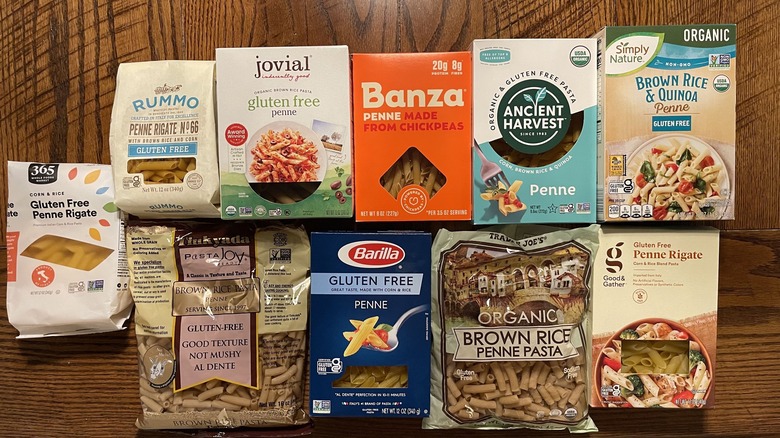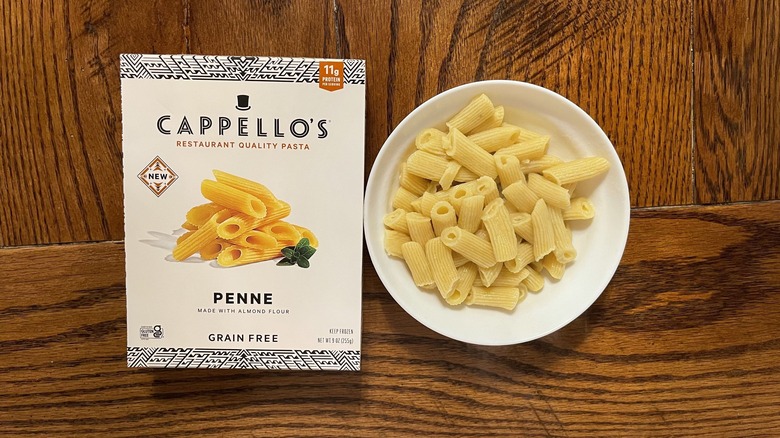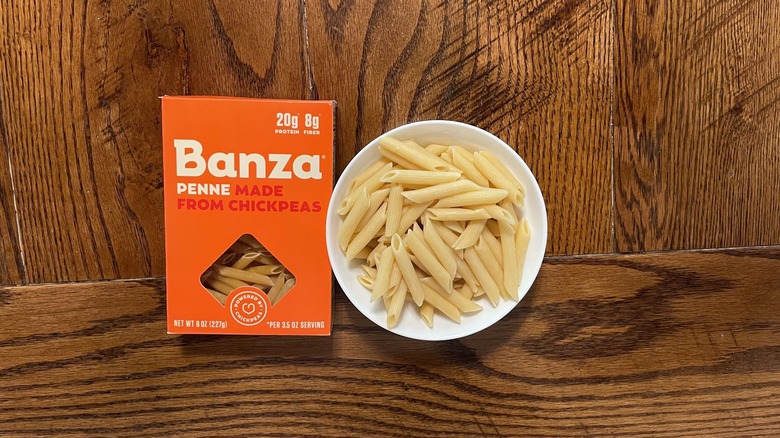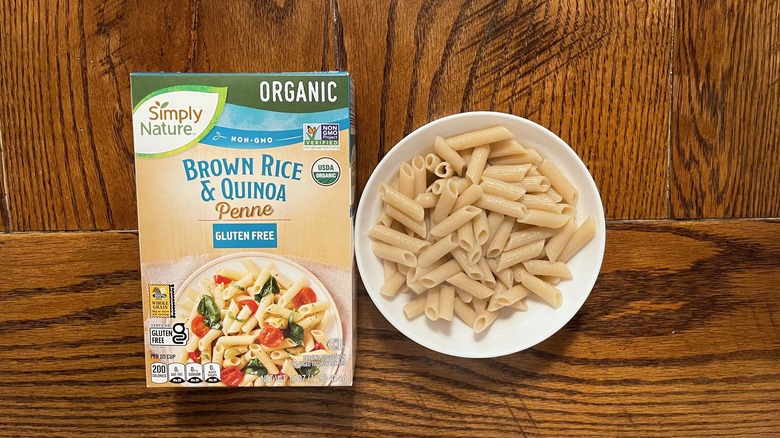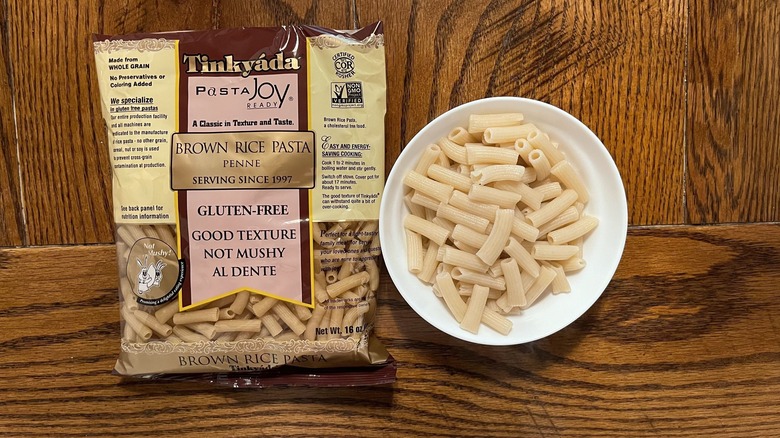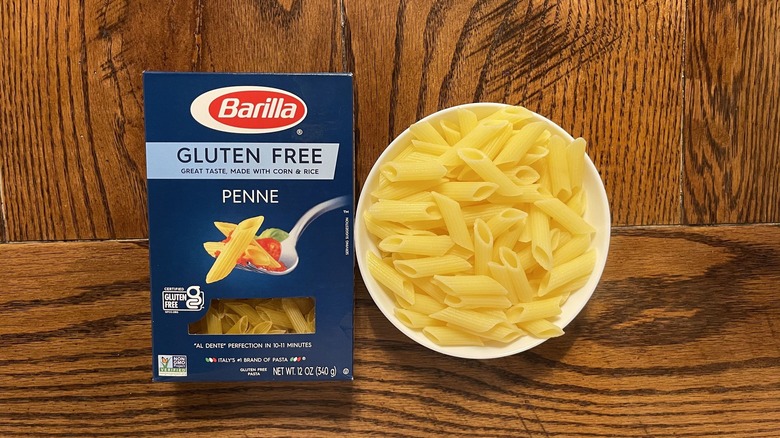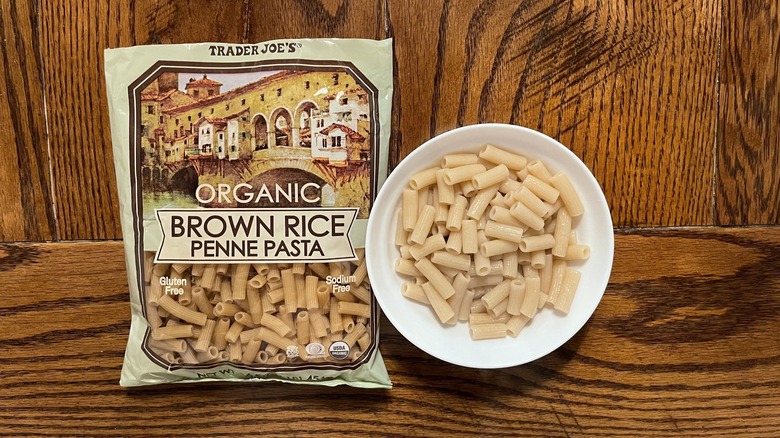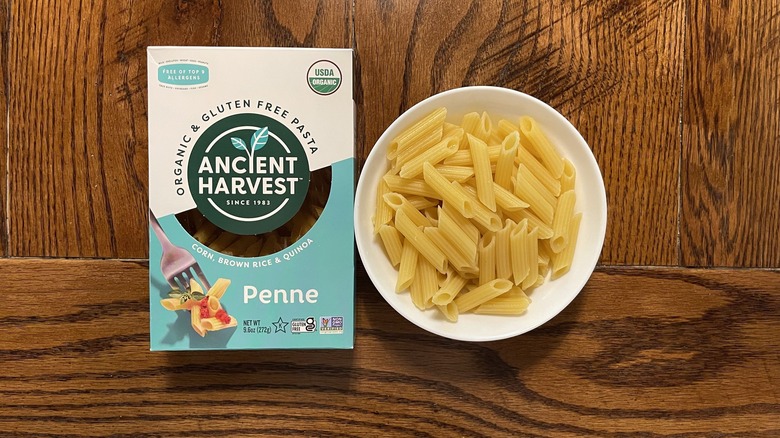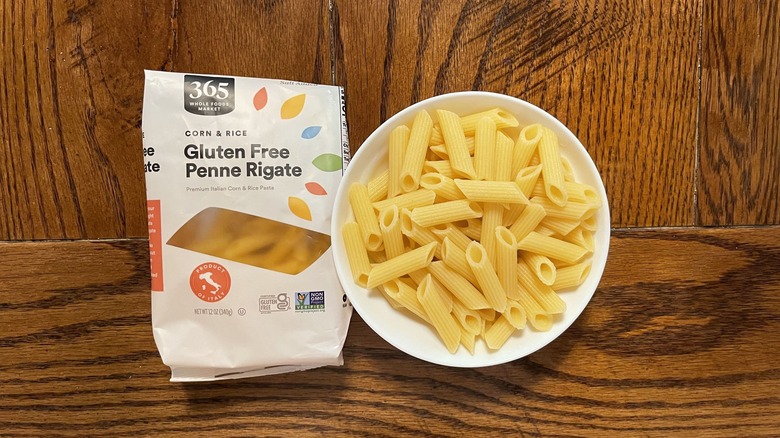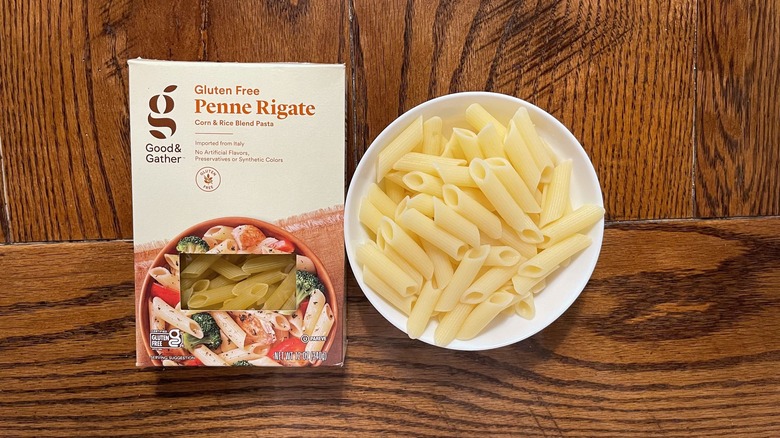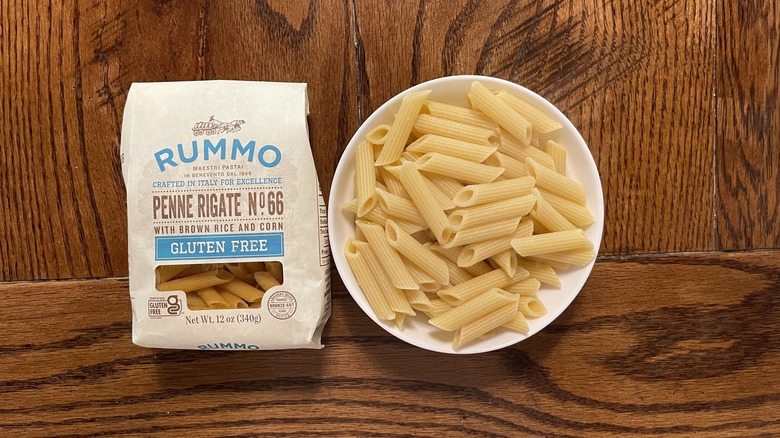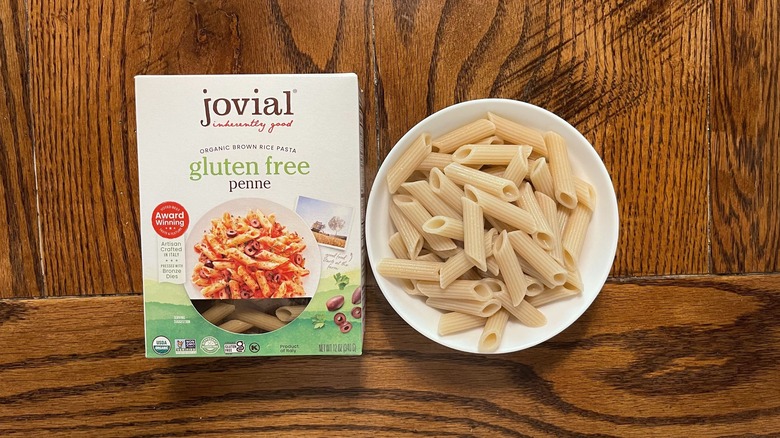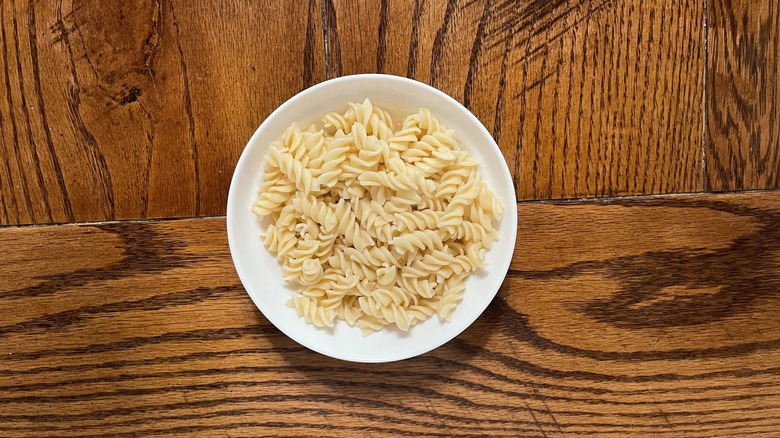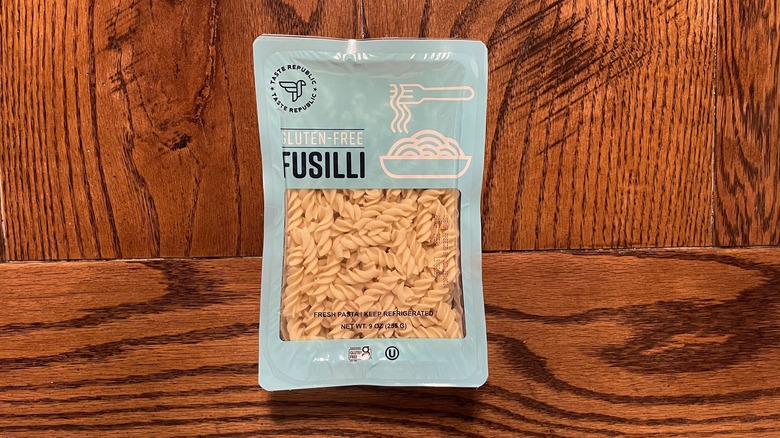12 Gluten-Free Pasta Brands, Ranked Worst To Best
We may receive a commission on purchases made from links.
It's not just folks with celiac disease or gluten sensitivities who live gluten-free. In fact, there are a number of reasons why people may decide to avoid gluten in their diets, and brands have responded by offering a variety of gluten-free foods catered to those consumers. As a carb lover who's been gluten-free for almost 10 years, I can say I've tried my fair share of gluten-free products, including pastas. Of course, given the various types of gluten-free pasta options (and potential ingredients used), not every gluten-free brand tastes the same — and some are much better than others.
Quite frankly, many gluten-free pasta options leave a lot to be desired. To help you avoid throwing money away trying out brand after brand for yourself, then, I conducted a taste test to determine, once and for all, which gluten-free options most resemble traditional pasta made with wheat. I tried the same (or similar) type of gluten-free pasta from each brand, then judged (and ranked) them on several key factors, including taste, texture, and general cost. If you're wondering which options are worth your hard-earned cash, here are 12 gluten-free pasta brands ranked from worst to best.
12. Cappello's
Located in the frozen aisle, Cappello's goes a step further in its gluten-free efforts by removing grains entirely from its pasta (as noted on the box). Comprised mainly of almond flour and eggs, this gluten-free pasta brand also contains a surprising amount of protein with 11 grams per serving. Since it cooks in less than two minutes, as well, it may seem like a great choice to keep on hand for quick meals. However, the positives stop there for Cappello's and its gluten-free pasta.
Not only was Cappello's the priciest option I encountered, but its taste and texture were so far off from what you'd find with traditional pasta that I'd say it's not even comparable. Frankly, you can visibly tell this pasta contains no gluten before you even taste it. The noodles were mushy on the outside and tough on the inside, with a very distinctive taste and smell (and not in a good way).
The noodles also had a strong egg-like flavor that lingered far too long after I finished eating. Given the poor taste and just how unrecognizable it is next to traditional pasta, Cappello's comes in at the bottom of this list.
11. Banza
Made with chickpea flour, Banza provides more nutritional benefits than most other gluten-free pasta brands. After all, according to the company, a single serving contains 50% more protein, triple the fiber, and 25% fewer carbs than traditional pasta. While this is great news for someone who wants to maximize every meal they eat (nutritionally speaking, that is), Banza doesn't exactly offer an authentic pasta eating experience with its gluten-free option.
Using chickpeas as the main ingredient unfortunately results in a very chickpea-forward flavor profile, along with a slightly grainy and gritty texture. Additionally, while you might expect a pasta made from chickpeas to remain a bit more al dente than other types of gluten-free pasta, Banza's penne started to fall apart on the plate. Now, unlike Cappello's, you can at least tell what this gluten-free pasta brand is when looking at it, so Banza avoids last place. But since it's clear to anyone that this isn't traditional pasta after just one bite, it comes near the bottom.
10. Simply Nature
Given its reputation as one of the most affordable grocery stores, I wasn't surprised to find Aldi's Simply Nature gluten-free pasta available at a fantastic price. Made with brown rice and quinoa, you can tell this product is gluten-free due to the strong flavor it gives off as a result of its main ingredients. Even though it wasn't quite as flavorless as the lower-ranked gluten-free pastas, this brand loses a lot of points for texture.
This gluten-free pasta is extremely grainy and gritty, and even a little slimy (which a quick rinse didn't seem to help). More than that, you have to time your cooking just right; if it's merely a minute too long, it starts to turn to mush. The shape is also much smaller than traditional penne. Seeing how noodle shape is nearly as important to an enjoyable pasta as the taste and texture, this gluten-free brand leaves you wanting a lot more.
Simply Nature may hold up better than Banza if you cook it right, and it's less obvious that you're eating a wheat-free penne (at least within the first few bites). However, while these factors keep it above the bottom two brands, chances are you won't be a repeat buyer unless it's your only option.
9. Tinkyáda
Other than its slightly different shape, Tinkyáda's brown rice penne seems pretty average upon first glance. Once it starts to cook, though, you'll immediately start to see how thin it actually is. I knew it would be a challenge not to overcook this gluten-free pasta brand from the start, and therefore had to babysit the pasta while it cooked more than I'd have liked. Yet even with a watchful eye, the pasta started to break apart as soon as I poured it into a strainer. This left me little hope for how well it would hold up when mixed with sauce (let alone how well it would stand up to a fork).
Simply put, even though the phrase "not mushy" is clearly noted on the packaging, this product doesn't live up to its marketing. In short, I've never seen a pasta start to fall apart as quickly as this penne from Tinkyáda. Now, to its credit, this gluten-free pasta tasted more like traditional wheat pasta than the lower-ranked pastas, which ensured it ranked above those entries. But Tinkyáda's texture and durability let me down overall and kept it from placing higher on the list.
8. Barilla
Barilla may be the most easily accessible gluten-free pasta brand. Sold seemingly everywhere, including large retail stores and grocery chains, chances are you'll find Barilla on store shelves. It also comes in at a great price point, which makes going gluten-free easier on your wallet. Unfortunately, it's not exactly akin to traditional pasta.
The first thing you notice when you take the pasta out of the box is how thin it is; in fact, it's almost translucent. Now, that's not really a deal breaker at face value, but it ends up translating to cooked pasta that's very delicate and falls apart quickly if cooked too long. Because of this, you also have to be mindful of what dishes you plan to make with this gluten-free option, as overmixing with sauce or reheating can result in ripped apart pasta.
All that being said, since Barilla uses a corn and rice mixture, the taste is much more on point with traditional pasta than several other options. While its overall flavor profile was enough to rank above the lower list entries, its delicate texture and durability issues keep it from placing higher.
7. Trader Joe's
As far as gluten-free pasta goes, Trader Joe's lands pretty much in the middle of the pack (hence its ranking placement). It's not quick to get mushy, but it also isn't perfectly al dente and has a tad more firmness than some other gluten-free options on this list. Additionally, while the taste isn't exactly overbearing, per se, you can still tell it's not wheat pasta after one bite. Now, to be fair, this isn't really a bad thing. In fact, while it won't fool any gluten-loving friends or family who're served this, the overall flavor is pretty mild, and essentially what you'd expect from brown rice.
The gluten-free penne from Trader Joe's is also shaped a bit differently than other varieties — coming in shorter and rounder — allowing it to hold up well to both cooking and reheating. This makes it extremely versatile in most sauce-based pasta dishes and is why it's one of my go-to choices for numerous baked pasta recipes. It's not the best gluten-free pasta brand on the market, but it's not the worst, either.
6. Ancient Harvest
A number of gluten-free pasta brands utilize a blend of corn and white rice to mimic traditional pasta, and Ancient Harvest changes this up a bit by adding quinoa to the mix. Now, it's not uncommon for gluten-free pastas that contain these types of grains to have a distinct flavor profile. But I was pleasantly surprised to discover this wasn't the case with Ancient Harvest's penne. I'd go so far as to say there wasn't any other flavor present besides what you'd expect from a traditional pasta.
Unfortunately, while this gluten-free pasta didn't fall apart or get mushy, it did go a bit too far in the opposite direction. In fact, the reason Ancient Harvest ranks in the middle (and not higher) is that it has a bit of a chewy, rubbery texture that negated just how good it tasted. If it wasn't for this, Ancient Harvest would probably rank closer to the top. But the reality is what it is, and the higher-placed gluten-free pasta brands were simply more comparable to traditional pasta in every key aspect (not just one or two areas).
5. Whole Foods 365
To be honest, it was difficult to find any notable differences between Whole Foods 365 gluten-free penne and the next brand on the list (Target's Good & Gather brand). Each brand is made with similar ingredients, each is produced in Italy, and the two were incredibly close in terms of cook time, size, texture, and firmness. But one has to outshine the other in some aspect — and for me, the taste was the key.
Perhaps I wouldn't be able to tell the difference if someone handed me a plate of this and said it was the Good & Gather brand. However, since I had the ability to taste each brand side-by-side, I can confidently say the Whole Foods 365 option was a fraction worse than the slightly higher-placed brands.
Additionally, the potential lack of availability for this particular gluten-free pasta brand was a factor. Not everyone is apt to have a Whole Foods Market nearby, after all, but most people are likely to have a Target or a similar store within driving distance.
4. Good & Gather
Target's brand of gluten-free pasta utilizes corn and rice. These are two of the most common ingredients in gluten-free pasta because the combination makes a noodle that holds up to both cooking and reheating. What I loved best about the Good & Gather pasta is that it doesn't skimp on quality in order to achieve a lower price point. It wouldn't necessarily confuse your tastebuds for gluten (as the texture and taste still varies ever so slightly from traditional pasta), but it's still an admirable impression.
I love that this gluten-free pasta brand held its shape, nor was it so delicate that I had to worry about it falling apart. The cook time may have been on the longer end of gluten-free pasta brands on this list, but I didn't have to sit around watching the water and testing multiple noodles to ensure they didn't overcook.
In short, there are very few gluten-free pastas on the market that deliver this kind of accessibility, quality, and overall value. While it wasn't quite as capable of fooling me as the top three entries, it's still a solid option.
3. Rummo
Made in (and imported from) Italy, Rummo utilizes a blend of rice and corn. While this is similar to several other brands on this list, there's one notable addition: potato starch. Of course, there's a reason why potato starch can be found in a wide variety of recipes. In this Rummo product, it helps deliver a penne pasta extremely similar in both taste and texture to what you'd find with traditional pasta — boosting it into third place on this list.
One of the best things about Rummo pasta is that there was little guessing when cooking it. It cooked in the exact time frame that the package indicated without having to constantly watch the pot out of fear of overcooking. It was perfectly al dente, as well, and held up when cooking, eating, and reheating. Rummo's gluten-free pasta had the light flavor you'd expect from traditional pasta. This helped put it in the top three of gluten-free pastas (even if it didn't do quite as well as the top two in emulating the familiar taste of wheat-based pasta).
2. Jovial
There are very few gluten-free pasta brands that have fooled my friends and family like Jovial. For starters, there's none of the grittiness or unpleasant taste that often occurs in other products where brown rice is the main ingredient. It's also one of the only dried gluten-free pastas that tastes even remotely similar to both dried and fresh wheat pasta.
On par with the other top brands on this list, Jovial handcrafts traditional bronze-cut and dried pasta in Italy. This means the pasta is cut and shaped from a specific type of mold. Since this results in a coarser texture on each piece of pasta, it doesn't disintegrate before you can take your first bite, which helps the gluten-free brand retain its shape even when you're eating reheated leftovers.
Furthermore, the cook time is straightforward and lines up exactly with what the package recommends (unlike several lower-ranked options). With its spot-on durability, texture, and flavor, there was only one other gluten-free pasta brand that bested Jovial when considering every factor.
1. Taste Republic
A rarity for gluten-free pasta brands, Taste Republic specializes in fresh instead of dried pasta. Located in the refrigerated section of the grocery store, Taste Republic has a complete line of different pasta types, including fettuccine, linguine, and even specialty tortellini, such as four cheese and cacio e pepe. Simply put, both the taste and texture of its fusilli variety are akin to traditional pasta — far more than any other gluten-free brand on the market, earning Taste Republic the top spot.
Quite frankly, if I didn't cook this pasta myself, I'd have second-guessed whether or not I was actually eating a gluten-free variety. Beyond the near-perfect replication of wheat pasta's flavor profile, this gluten-free option cooked in only two minutes — and was perfectly al dente when finished. Another thing that helps Taste Republic stand out from the pack is its line of grain-free pasta made with cauliflower, chickpeas, and lentils. Between its ability to allow even more people to enjoy a bowl of pasta without concern and top-tier taste and texture, Taste Republic is the overall winner for gluten-free pasta brands.
Methodology
With seemingly endless options on the market, the choices were narrowed down to gluten-free pasta brands found in most grocery stores across the U.S. Whether you live in a small town or big city, chances are you can get at least one of these at a local store. Also, since there are multiple pasta shapes, I tried to compare the same shape in order to judge fairly. Since most brands make penne — with the exception of Taste Republic — it was the obvious choice for comparison.
Though cost and widespread availability were considered, ultimately, two main factors determined the rankings order: texture and taste. I considered how well each brand held up during and after cooking, as well as when reheated. Nothing is worse than a mushy plate of pasta that falls apart before it can get on your fork. I also judged each brand on how much it tasted like regular wheat pasta (with gluten). The various ingredients used to make gluten-free pastas often have a unique flavor of their own, after all, so it was important to note whether or not a pasta had any aftertaste or flavors beyond what you'd find with traditional pasta.
